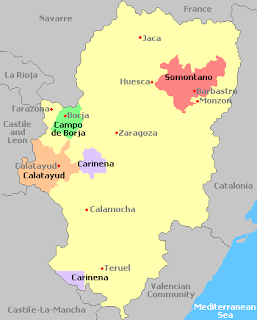Aragon is, according to Pedros Ballesteros Torres, an "emergent Spanish wine region."
Aragon is a culturally significant autonomous Spanish community which hosts four DOs within the confines of its border: Somontano to the north and Campo de Borja, Cariñena, and Calatayud to the south. The landscape covered by these DOs range from snow-capped peaks in the north, to parched plains in the south, and green hills in between.
 |
| Aragon DO (Source: wineandvinesearch.com) |
The climate is continental, with altitude as a key modifier. The Pyrenees and other elevated areas in the north, and some areas in the south, are cooler. Vineyards in these locations are sited at between 500 and 1000 m altitude. Conversely, altitude in the middle of the DO comes in at around 200 m.
The cierzo (north wind) is a strong, dry, and very cold wind channeled by the Ebro River Valley. It mitigates temperatures as well as disease uptake on the fruit or vines.
Soils herein are predominantly chalk and clay.
Until the 1990s, large-scale farming and bulk-wine production were the heart of the Avignonese wine industry; a lot more of the wine is bottled today. Garnacha is the main cultivar planted but there is significant representation from Cariñena and Tempranillo.
Internal DOs
DO Somontano
DO stautus awarded in 1984. The vines are planted in the terraces of the valleys that lead to the northern part of the Ebro Valley. This zone produces balanced, fruity red wines (a mix of international and indigenous varieties) and crispy, refreshing whites (Macabeo, Garnacha Blanca, Chardonnay, among others).
DO Campo de Borja
This DO is blessed with a plethora of Garnacha vines, some with serious age. An extreme continental climate with fog from the Ebro River adding humidity.
Production is primarily young red and rosé wines with white wines only 8% of the total. In addition to Garnacha, Tempranillo, Mazuelo, and Cabernet Sauvignon are the red varieties planted.
The wines from this region are "denser, with more fruity aromas and personality than Cariñena wines."
DO Cariñena
This region was awarded DO status in 1932 but has a wine-making history which stretches back to Roman times. It was first officially delimited in 1696.
The climate is continental, with the extreme temperatures, low rainfall, hail, and cierzo providing a multitude of challenges for the area's growers. Most of its vineyards are located on the Cariñena Plain and its surrounds where the soil is limestone over rock, slate, or alluvial.
Garnacha is the most widely planted red (55%) while Macabeo is the most popular white variety.
DO Calatayud
This region was awarded DO status in 1989.
The climate is continental, with very hot and dry summers, very cold winters, and significant temperature excursions. The climate is mitigated by vineyard altitude: the south-facing slopes of the Sierra de Virgin mountain range can reach elevations of up to 800m. The area can experience frost for over half the year with the attendant threat of vine damage.
The soils are loose and rocky with generous limestone contribution. They are well drained.
Big, bold reds from Garnacha (75% of plantings) are the region's staple wine. Other red varieties include Tempranillo and Mazuelo. The white varieties are Macabeo, Malvasia, and Chardonnay.
Why Aragon DO as an Emergent Region?
According to spanish-living.com:
Aragon has concentrated on improving its wine production techniques, selecting the grape varieties with an eye to quality and streamlining traditional cultivation methods. The progress that has been made is noteworthy, though more pronounced in some regions than in others.
******************************************************************************************************
The regions identified as emergent by Torres in his initial article are:
No comments:
Post a Comment